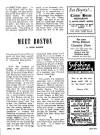
Home Page Meet Boston Menu Index
|
MEET BOSTON Friday, April 17, 1942 in What's New In Town W. J. Sidis |
Correction again. In the recent item on Boston mirages, the descriptions should not have been in quotation marks. An unpublished manuscript was referred to as the source of one of the two descriptions (not of both); nut there was no attempt to use the author’s exact words. The sinking of the Squalus happened since the manuscript was written, so could not have been quoted. Our apologies to the author of “American Descriptions.”
*
With the number of bridges now spanning the Charles, it is hard to realize that, at the time of the American Revolution, there was no bridge across the Charles below the “Great Bridge,” the present location of the Larz Anderson Bridge. It was over that bridge that William Dawes rode on the midnight ride, [Tuesday] April 18, 1775, to warn Middlesex of a coming raid by the occupying British Militia―while another messenger, Paul Revere, carried the same warning via “the Charlestown shore” and “the bridge into Medford town.” It was over the same bridge that the raiding redcoats―at least a part of the raiding expedition―crossed, the Brookline minutemen had removed the planks forming the bridge roadway, but a few redcoats swam the river, got the planks on the Cambridge side, and put them back. As late as 1913 the old bridge stood, in an extremely rickety condition―maybe as a result of its experiences of 1775. It was then replaced by the present Larz Anderson Bridge. The old “Great Bridge” was part of an old road to Cambridge through Brookline, Roxbury, and “The neck” (Washington Street in the South End). Old milestones are still to be seen along that road, which is still called Harvard Street in Brookline and Harvard Avenue in Allston. The 5-mile stone is in front of the Congregational Church in Brookline, the 6-mile stone is in the Allston shopping district, and the 8-mile stone is in front of a cemetery near Harvard Square, Cambridge.
*
The world’s first telephone subscriber was a Somerville man, who got a pair of telephones in 1876 to communicate with his Boston office in Scollay Square. The home that had this first telephone service was at Arlington and Lincoln Streets, in East Somerville, not far beyond Sullivan Square. It would appear, then, that the first commercial use of the telephone between home and office―possibly to call up both places with excuses for lateness. Many people have been doing that ever since.
*
Boston has the most powerful short-wave radio station on Earth. It is heard all round the world.